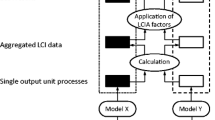Abstract
Quantile regression methods are evaluated for computing predictions and prediction intervals of NOx concentrations measured in the vicinity of the power plant in As Pontes (Spain). For these data, smaller prediction errors were obtained using methods based on median regression compared with mean regression. A new method to construct prediction intervals involving median regression and bootstrapping the prediction error is proposed. This new method provides better coverage for NOx data compared with classical and bootstrap prediction intervals based on mean regression, as well as simpler prediction intervals based on quantile regression. A simulation study illustrates the features of this proposed method that lead to a better performance for obtaining prediction intervals for these particular NOx concentration data, as well as for any other environmental dataset that do not meet assumptions of homoscedasticity and normality of the error distribution.



Similar content being viewed by others
References
Cade BS, Noon BR (2003) A gentle introduction to quantile regression for ecologists. Front Ecol Environ 1:412–420
Chernozhukov V (2005) Extremal quantile regression. Ann Stat 33:806–839
Conde-Amboage M, Sánchez-Sellero C, González-Manteiga W (2015) A lack-of-fit test for quantile regression models with high-dimensional covariates. Comput Stat Data Anal 88:128–138
Fahrmeir L, Kneib T, Lang S, Marx B (2013) Regression: models, methods and applications. Springer, New York
Feng X, He X, Hu J (2011) Wild bootstrap for quantile regression. Biometrika 98:995–999
Fernández-Castro BM, Prada-Sánchez JM, González-Manteiga W, Febrero-Bande M, Bermúdez-Cela JL, Hernández-Fernádez JJ (2003) Prediction of \(SO_{2}\) levels using neural networks. J Air Waste Manag Assoc 53:532–538
Fernández-Castro BM, Guillas S, González-Manteiga W (2005) Functional samples and bootstrap for predicting sulfur dioxide levels. Technometrics 47:212–222
Fernández-Castro BM, González-Manteiga W (2008) Boosting for real and functional samples: an application to an environmental problem. Stoch Environ Res Risk Assess 22:27–37
Fontanella L, Ippoliti L, Sarra A, Valentini P, Palermi S (2015) Hierarchical generalised latent spatial quantile regression models with applications to indoor radon concentration. Stoch Environ Res Risk Assess 29:357–367
García-Jurado I, Gonzalez-Manteiga W, Prada-Sánchez JM, Febrero-Bande M, Cao R (1995) Predicting using Box-Jenkins, nonparametric and bootstrap techniques. Technometrics 37:303–310
Hall P, Yao Q (2005) Approximating conditional distribution functions using dimension reduction. Ann Stat 33:1404–1421
Hall P, Wolff RCL, Yao Q (1999) Methods for estimating a conditional distribution fuction. J Am Stat Assoc 94:154–163
Koenker R (1994) Confidence intervals for regression quantiles. In: Proceedings of the 5th Prague symposium on asymptotic statistics. Springer, New York, pp 349–359
Koenker R (2005) Quantile regression. Cambridge University Press, Cambridge
Koenker R, Bassett G (1978) Regression quantiles. Econometrica 46:33–50
Li Q, Racine JS (2007) Nonparametric econometrics: theory and practice. Princeton University Press, Princeton
Mayr A, Hothorn T, Fenske N (2012) Prediction intervals for future BMI values of individual children: a non-parametric approach by quantile boosting. BMC Med Res Methodol 12:6
Meinshausen N (2006) Quantile regression forests. J Mach Learn Res 7:983–999
Nanos N, Grigoratos T, Rodríguez-Martín JA, Samara C (2015) Scale-dependent correlations between soil heavy metals and As around four coal-fired power plants of northern Greece. Stoch Environ Res Risk Assess 29:1531–1543
Prada-Sánchez JM, Febrero-Bande M (1997) Parametric, non-parametric and mixed approaches to prediction of sparsely distributed pollution incidents: a case study. J Chemom 11:13–32
Prada-Sánchez JM, Febrero-Bande M, Cotos-Yáñez T, González-Manteiga W, Bermúdez-Cela JL, Lucas-Domínguez T (2000) Prediction of \(SO_{2}\) pollution incidents near a power station using partially linear models and a historical matrix of predictor-response vectors. Environmetrics 11:209–225
Roca-Pardiñas J, González-Manteiga W, Febrero-Bande M, Prada-Sánchez JM, Cadarso-Suárez C (2004) Predicting binary time series of \(SO_{2}\) using generalized additive models with unknown link function. Environmetrics 15:729–742
Roca-Pardiñas J, Cadarso-Suárez C, González-Manteiga W (2005) Testing for interactions in generalized additive models. Application to \(SO_{2}\) pollution data. Stat Comput 15:289–299
Salama A (2005) A note on the impact of environmental performance on financial performance. Struct Chang Econ Dyn 16:413–421
Seber GAF (1977) Linear regression analysis. Wiley, Hoboken
Shi JP, Harrison RM (1997) Regression modelling of hourly \(NO_x\) and \(NO_2\) concentrations in urban air in London. Atmos Environ 31:4081–4094
Sousa SIV, Pires JCM, Martins FG, Pereira MC, Alvim-Ferraz MCM (2009) Potentialities of quantile regression to predict ozone concentrations. Environmetrics 20:147–158
Stine RA (1985) Bootstrap prediction intervals for regression. J Am Stat Assoc 80:1026–1031
Zhou KQ, Portnoy SL (1996) Direct use of regression quantiles to construct confidence sets in linear models. Ann Stat 24:287–306
Acknowledgments
This study was supported by Project MTM2013-41383P from the Spanish Ministry of Economy and Competitiveness, as well as the European Regional Development Fund (ERDF). Support from the IAP network StUDyS from the Belgian Science Policy is also acknowledged. M. Conde-Amboage was supported by FPU grant AP2012-5047 from the Spanish Ministry of Education. Comments and suggestions from two referees are gratefully acknowledged.
Author information
Authors and Affiliations
Corresponding author
Rights and permissions
About this article
Cite this article
Conde-Amboage, M., González-Manteiga, W. & Sánchez-Sellero, C. Predicting trace gas concentrations using quantile regression models. Stoch Environ Res Risk Assess 31, 1359–1370 (2017). https://doi.org/10.1007/s00477-016-1252-4
Published:
Issue Date:
DOI: https://doi.org/10.1007/s00477-016-1252-4




